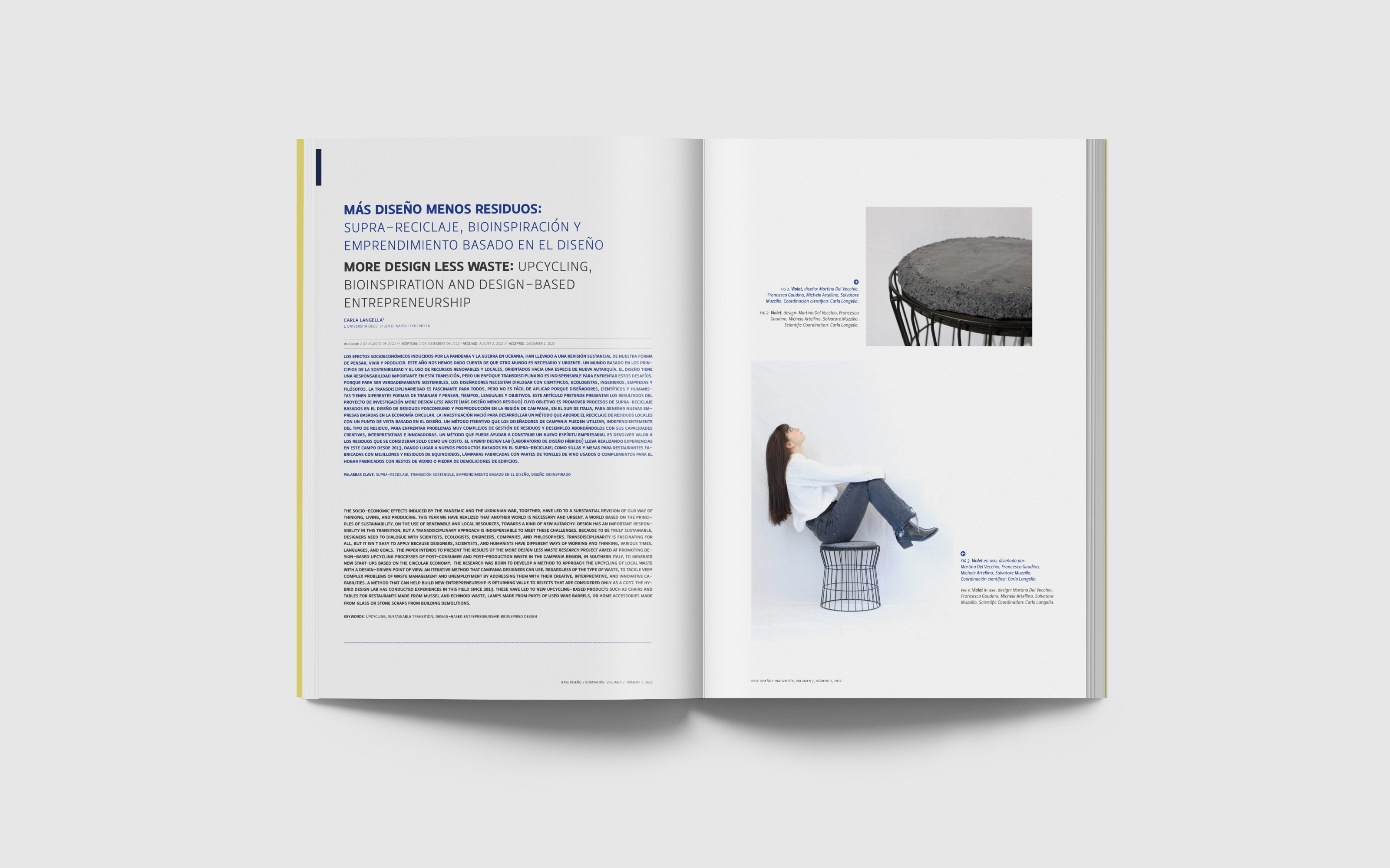More design, less waste Upcycling, bioinspiration and design-based entrepreneurship
Main Article Content
Abstract
The socio-economic effects induced by the Pandemic and the Ukrainian war, together, have led to a substantial revision of our way of thinking, living, and producing. This year we have realized that another world is necessary and urgent. A world based on the principles of sustainability, on the use of renewable and local resources, towards a kind of new autarchy. Design has an important responsibility in this transition, but a transdisciplinary approach is indispensable to meet these challenges. Because to be truly sustainable, designers need to dialogue with scientists, ecologists, engineers, companies, and philosophers. Transdisciplinarity is fascinating for all, but it isn't easy to apply because designers, scientists, and humanists have different ways of working and thinking, various times, languages, and goals. The paper intends to present the results of the More Design Less Waste research project aimed at promoting design-based upcycling processes of post-consumer and post-production waste in the Campania region, in southern Italy, to generate new start-ups based on the circular economy. The research was born to develop a method to approach the upcycling of local waste with a design-driven point of view. An iterative method that Campania designers can use, regardless of the type of waste, to tackle very complex problems of waste management and unemployment by addressing them with their creative, interpretative, and innovative capabilities. A method that can help build new entrepreneurship is returning value to rejects that are considered only as a cost. The Hybrid Design Lab has conducted experiences in this field since 2013. These have led to new upcycling-based products such as chairs and tables for restaurants made from mussel and echinoid waste, lamps made from parts of used wine barrels, or home accessories made from glass or stone scraps from building demolitions.
Article Details
References
Ad?güzel, F., & Donato, C. (2021). Proud to be sustainable: Upcycled versus recycled luxury products. Journal of Business Research, 130, 137-146. https://doi.org/10.1016/j.jbusres.2021.03.033
Baker-Brown, D. (2018). Who is mining the Anthropocene? In M. Charter (Ed.) Designing for the Circular Economy (pp. 336-343). Routledge.
Bergman, M. M. (2020). The world after COVID. World, 1(1), 45-48. https://doi.org/10.3390/world1010005
Bocken, N. M., de Pauw, I., Bakker, C., & van der Grinten, B. (2016). Product design and business model strategies for a circular economy. Journal of Industrial and Production Engineering, 33(5), 308-320. https://doi.org/10.1080/21681015.2016.1172124
D'Amato, D., Droste, N., Allen, B., Kettunen, M., Lähtinen, K., Korhonen, J., Leskinen, P., Matthies, B. D., & Toppinen, A. (2017). Green, circular, bio economy: A comparative analysis of sustainability avenues. Journal of cleaner production, 168, 716-734. https://doi.org/10.1016/j.jclepro.2017.09.053
European Commission. (2020). A new circular economy action plan for a cleaner and more competitive Europe. https://eur-lex.europa.eu/legal-content/EN/TXT/?qid=1583933814386&uri=COM:2020:98:FIN
Ferrara, M. (2021) Circular Material for Creative Industries: The Emerging Bioplastics. In L. Clèries, V. Rognoli, S. Solanki, & P. Llorach. Material Designers. Boosting talent towards circular economies (pp. 52-59) Creative Europe.
Fistola, R., Gargiulo, C., & La Rocca, R. A. (2020). Rethinking vulnerability in city-systems: A methodological proposal to assess “urban entropy”. Environmental Impact Assessment Review, 85, 106464. https://doi.org/10.1016/j.eiar.2020.106464
Giurca, A., Befort, N., & Taylor, A. (2022). Exploring transformative policy imaginaries for a sustainable Post-COVID society. Journal of Cleaner Production, 344, 131053. https://doi.org/10.1016/j.jclepro.2022.131053
Harper, K. H. (2017). Aesthetic Sustainability: Product Design and Sustainable Usage. Routledge.
Jorquera, D. (2015). Se puede generar una imagen país gracias al cobre. Base Diseño e Innovación, 2(1), 146-153. https://revistas.udd.cl/index.php/BDI/article/view/189/163
Kay, T. (1994, October 11) Reiner Pilz, Salvo Monthly 23, pp. 11-14. https://www.salvoweb.com/files/sn99sm24y94tk181119.pdf
Kyungeun, S. (2015). A review on upcycling: current body of literature, knowledge gaps and a way forward. In ResearchGate. Presented at the International Conference on Environmental, Cultural, Economic and Social Sustainability, Venice, Italy.
Langella, C. (2019). Design e scienza. List-Laboratorio Editoriale.
Langella, C. (2021). Design and science: a pathway for material design. In O. Pedgley, V. Rognoli, E. Karana (Eds.) Materials Experience 2. Expanding Territories of Materials and Design (pp. 259-277). Butterworth-Heinemann. https://doi.org/10.1016/B978-0-12-819244-3.00001-6
Mansilla, C. (2018). Aesthetics, new Materials, and efficient Functionality: The Environmentalist Agency of Marjan Van Aubel’s Objects. Diseña, 11(1), 220–240. https://doi.org/10.7764/disena.11.220-240
Perricone, V., Grun, T. B., Marmo, F., Langella, C., & Carnevali, M. D. C. (2020). Constructional design of echinoid endoskeleton: main structural components and their potential for biomimetic applications. Bioinspiration & Biomimetics, 16(1), 011001. https://doi.org/10.1088/1748-3190/abb86b
Santulli, C., & Langella, C. (2013). +design-waste: a project for upcycling refuse using design tools. International Journal of Sustainable Design, 2(2), 105-127. https://doi.org/10.1504/IJSDES.2013.057121
Sarenmalm, I. (2016). Would you like your receipt? Sustainability perspectives of consumer paper receipts [Master´s thesis] Department of Earth Sciences, Uppsala University.


